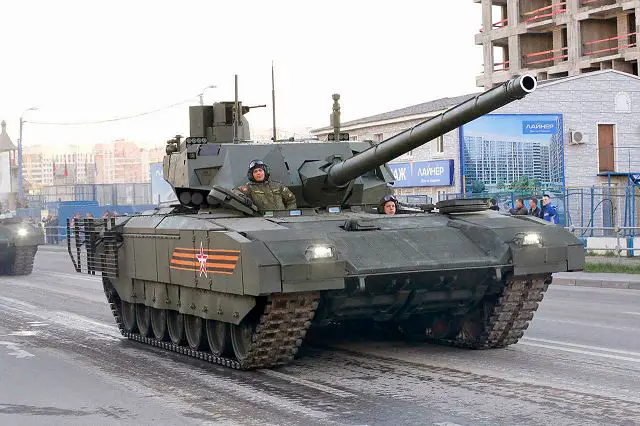Tactics of Russian motor rifle brigades will change with introduction of Armata tracked platform TASS 12407161
|
|
|||
|
Armies in the world - Russia
|
|||
|
|
|||
| Tactics of Russian motor rifle brigades will change with introduction of Armata tracked platform. | |||
|
The introduction of the Armata heavy tracked platform developed by the Uralvagonzavod (Russian acronym: UVZ) scientific-research corporation to armour and motor rifle brigades will drastically change the land tactics of Russian Armed Forces and lead to the transition to the modular-type units, according to the Gazeta.ru online newspaper.
|
|||
|
|
|||
 Russian army T-14 Armata main battle tank at military parade in Mosccow, Russia. Russian army T-14 Armata main battle tank at military parade in Mosccow, Russia. |
|||
|
|
|||
|
Motor rifle units are extremely vulnerable to the enemy`s fire on the modern battlefield. However, the tactics has not been radically changed. One can often see an attack of main battle tanks (MBT) in line order supported by infantry fighting vehicles (IFV) and dismounted non-protected soldiers in the drills. Such a Cold-war era combat tactics became obsolete about 20 years ago. According to Russian defense analysts, such outdated approach to combat must be replaced by a modern one. The issuance of the Armata-based heavy armoured vehicles to the Land Forces` units will allow increasing the probability of the soldiers` survival on the modern battlefield.
Both IFVs and armoured personnel carriers (APC) have already revealed their combat potential as fire support, convoy, and reconnaissance means. At the same time, the aforementioned vehicles cannot boast of armour protection. For instance, the newest BMP-3M (M stands for upgraded, Modernizirovannaya) IFV developed by the Tractor Plants concern is armoured at Level 5 STANAG 4569 (all-round protection against 25mm tungsten alloy armour-piercing fin-stabilized discarding sabot (APFSDS) rounds at 500 m) and lacks additional applique armour. In the 1990s, the NII Stali scientific-research institute (now a subsidiary of the Tractor Plants concern) developed an explosive reactive armour (ERA) kit for BMP-3 designated as Kaktus (Cactus), but Russia`s Ministry of Defense (MoD) decided not to acquire it in large quantities. Hence, the BMP-3`s protection has not been enhanced at all. Hence, even the latest organic IFV of the Land Forces does not provide sufficient protection against enemy`s fire, let alone ageing BMP-2 that can be destroyed by the US M2 Bradley at 1,500 m distance through the medium of 25mm armour-piercing rounds. The armour protection specifications of BTR-80 / BTR-80A / BTR-82A APCs fall short of even those of BMP-2. Their frontal armour could withstand only several hits of 12.7mm heavy machinegun (for instance DShK or M2HB), while the sides are protected only against 7.62mm armour-piercing bullets. Hence, neither IFVs nor APCs could provide an effective fire support to Russian tanks on the modern battlefield. |
|||
|
|
|||
 Derivatsiya-PVO 57mm anti-aircraft artillery system based on BMP-3 IFV chassis Derivatsiya-PVO 57mm anti-aircraft artillery system based on BMP-3 IFV chassis |
|||
|
|
|||
|
The idea to introduce the joint armoured battle order to the tactics has gone down, since the motor rifle units of Russia`s Land Forces use vehicles with enormously varying armour protection. For instance, a motor rifle battalion operates heavy-armoured MBTs, medium-armoured IFVs, low-armoured APCs and non-armoured trucks. Previously, 120mm 2B11 Sani (Sledge) mortars were being transported by GAZ-66 light trucks that did not have armour protection at all. The usage of such battle order would result in extremely heavy losses as only heavy-armoured MBTs had a chance to reach the enemy`s next resistance line. Hence, IFVs, APCs, trucks, and dismounted soldiers could not survive on the battlefield. The infantry`s offensive was suppressed by the fire of the enemy`s small arms and light weapons (SALW). Hence, there is no need to increase the IFVs` firepower and mobility. Armour protection of IFVs and APCs seems to be the most vital feature on the modern battlefield. It should not come short of the tank protection level, Gazeta.ru supposes.
"We have hammered out an ideology of future land tactics based on the Armata heavy vehicles. The Uralvagonzavod Corporation offers to get rid of traditional units (such as brigade, battalion, company, etc.) and to switch to combat modules that will include both combat and support vehicles," the UVZ`s Deputy Director General for Military Vehicles, Vyacheslav Khalitov said. According to him, such combat module may include one or two T-14 Armata MBTs, a fire support vehicle (FSV) armed with 57mm automatic cannon, an FSV armed with 152mm howitzer, a mobile command post and a logistic support vehicle. "The aforementioned combat module`s combat potential will exceed the one of the present-day motor rifle and armour units. The module`s armour protection and mobility will not be graded," Khalitov added. According to him, the organizational structure of the combat module can be adjusted to all types of terrain. "The combination of combat modules is required to complete various tasks. The module can be complemented by self-propelled surface-to-air (SAM) missile systems, artillery units, armoured engineering vehicles, mechanized bridge layers, mine clearance vehicles, and mine planters. Hence, the organizational structure of the new combat module can be easily adapted to all types of combat environment. Such flexible approach is the tactics of future," Khalitov said. Hence, the Armata heavy platform can drastically change the modern battlefield. |
|||
|
|
|||
|
© Copyright 2016 TASS. All rights reserved. This material may not be published, broadcast, rewritten or redistributed.
|
|||


























